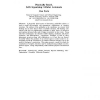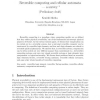12 search results - page 1 / 3 » Physically Based, Self-Organizing Cellular Automata |
DAI
1998
Springer
13 years 9 months ago
1998
Springer
A physically based system of interacting polyhedral objects is used to model self-assembly and spontaneous organization of complex structures. The surfaces of the polyhedra in the ...
PC
2006
13 years 4 months ago
2006
Cellular automata (CA) are discrete dynamic systems that have been used for modeling many physical systems. CA are often used as an alternative to model and solve large-scale syst...
ICCAD
2005
IEEE
14 years 1 months ago
2005
IEEE
— When exploring computing elements made from technologies other than CMOS, it is imperative to investigate the effects of physical implementation constraints. This paper focuses...
TCS
2008
13 years 4 months ago
2008
Reversible computing is a paradigm where computing models are so defined that they reflect physical reversibility, one of the fundamental microscopic physical property of Nature. ...
ACRI
2004
Springer
13 years 10 months ago
2004
Springer
Cellular automata (CA) are highly parallel and discrete dynamical systems, whose behavior is completely specified in terms of a local relation. They were successfully applied for s...


